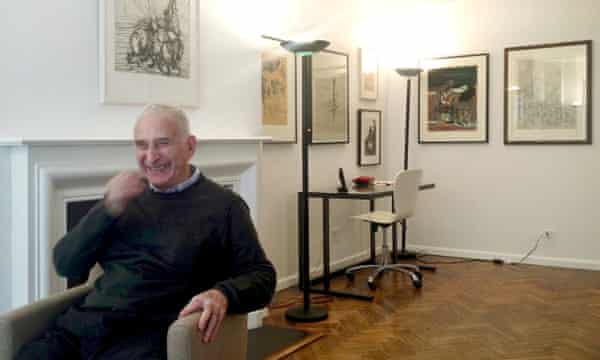 |
| Detail from Red, Black & Blue by Sam Francis (1958), included in Linda Karshan’s gift to the Courtauld Gallery. Photograph: Richard Valencia Photography/Courtauld Institute |
Drawings by Cézanne and Klee among works gifted to Courtauld Gallery
Assembled by the late collector Howard Karshan, the ‘revelatory’ collection is hailed as important beyond its size
Kwes / Why I love Paul Klee
My hero / Paul Klee by Philip Hensher
A collection of modern drawings that the head of London’s Courtauld Gallery says push the boundaries of what the art form can be has been gifted to the gallery.
It said the set of 25 works by artists including Cézanne, Kandinsky and Klee was one of the most significant gifts of art it had received in a generation. They were assembled by the collector Howard Karshan, who died in 2017, and presented in his memory by his wife, Linda, an artist herself.
Ernst Vegelin van Claerbergen, the head of the gallery, said the gift was “important beyond its size” because of the gaps it filled and the nature of the works. The gallery has one of the nation’s great drawing collections, with 7,000 works by artists including Leonardo, Rembrandt and Rubens.
“It is also one of the most active collections in terms of exhibitions and displays and loans,” said Vegelin. “Despite that, our representation of draughtsmanship in the 20th century is hesitant, so this gives us a fantastic new chapter in the collection and a great basis for future growth.
“Other than Cézanne, none of the artists in the gift are in the collection at all. No Kandinsky, no Klee and so forth, so this brings them in, where they belong.”

There are drawings by great names but also “astonishing and revelatory” works by artists less well known to the wider public. For example, an explosively colourful work by the Californian abstract expressionist Sam Francis, and abstract works by Henri Michaux made while he was tripping on mescaline.
There are also two works by the fascinating Swiss artist Louis Soutter, who was institutionalised, put in a home for elderly men, when he was 52. After he developed osteoarthritis, Soutter would dip his fingers in ink and work directly on paper.
Vegelin said the results were astonishing, describing one work, the figures swaying frieze-like, as “a drop-dead masterpiece. When I first saw it, it stopped me literally in my tracks.”
He said the art works made a case for drawing on its own terms, not just as preparatory studies for paintings. “It is not a collection that someone has put together from a reference book, it is a collection with real edge and bite and character that really gets under the skin of drawing as an art form.”
The works, which also include examples by Cy Twombly, Georg Baselitz and Joseph Beuys, were “gutsy, full-on drawing as self-expression, really pushing the boundaries of the medium and exploring the edges of draughtsmanship.”
Linda Karshan said her husband was as passionate about studying his drawings as he was about collecting them. “He carefully positioned them on the walls around him, so as to be able to have his favourites within sight,” she said.

“These are the drawings that make up the Karshan gift. At the Courtauld they will find their natural home, where they can be in the public eye while being studied for generations to come, echoing the role these drawings played within our family for over 50 years.”
The closed-for-modernisation Courtauld is home to one of Europe’s greatest art collections, with masterpieces including Van Gogh’s Self-Portrait with Bandaged Ear and Manet’s A Bar at the Folies-Bergère. The drawings will go on display when it reopens in late 2021 following its three-year, £50m renovation project.
Vegelin said Karshan and the gallery wanted people to be inspired by the works. “What is this going to do for people for decades to come? What will be the serendipitous moments be when a young student sees the Soutter and the scales fall from their eyes and they realise what they can do, what the possibilities are?”


No comments:
Post a Comment